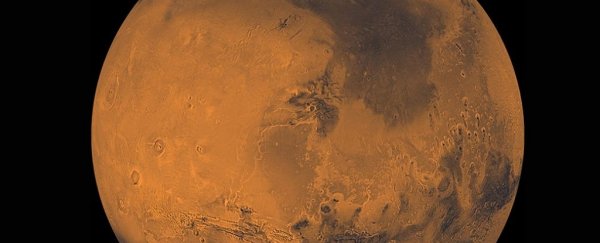By this time next year, Mars will be abuzz with robotic activity.
That's because three countries are sending spacecraft to the red planet this month. In the final weeks of July, the US, China, and the United Arab Emirates all plan to rocket rovers or orbiters into space.
NASA has sent five rovers to the red planet in the past, but this will be China's and the UAE's first attempts.
The robots are expected to make the first global map of the Mars climate, drill into the planet's surface, and search for signs of long-dead microbes that may have once thrived in Martian valleys and riverbeds. These missions could find the first footprints of life on another planet.
The launches are all scheduled for this month in order to catch Mars as it passes close to Earth. If they miss this chance, they won't have another opportunity to launch until 2022.
Russia and the European Space Agency had also planned to send a rover to Mars this year, but had to back out after the coronavirus pandemic caused delays. They will try again in two years.
Here's what to know about the three rovers slated to begin their journeys to Mars within the next few weeks.
NASA's Perseverance rover will stash rock samples to return to Earth
 An illustration of NASA's Perseverance rover. (NASA/JPL-Caltech)
An illustration of NASA's Perseverance rover. (NASA/JPL-Caltech)
Engineers began assembling Perseverance two years ago at NASA's Jet Propulsion Laboratory in Pasadena, California. It was previously called the Mars 2020 rover – a placeholder until NASA chose Perseverance as the winner of a naming competition.
"We as humans evolved as creatures who could learn to adapt to any situation, no matter how harsh," Alexander Mather, a 7th-grader from Virginia who proposed the new name, wrote in the essay he submitted to the competition. "We will meet many setbacks on the way to Mars. However, we can persevere."
NASA has already run into some of those setbacks. It has pushed back the launch date twice, delaying it to July 30. That leaves the agency just two more weeks of flexibility until the launch window closes on August 15.
If all goes well, the rover will land on February 18, 2021 in Mars' Jezero crater – an ancient riverbed that could harbour signs of past microbial life. The mission, which will cost a total $US3 billion start-to-finish, will drill into the Martian surface to collect samples of rock and soil, then stash them at a collection point for a future mission to bring back to Earth.
After it lands, the rover is programmed to drop a small helicopter from its belly.
The helicopter, called Ingenuity, is a technology demonstration. If successful, it will conduct the first-ever powered flight on another world.
Perseverance itself will carry a suite of cutting-edge tools: a new navigation system to make landing on the red planet less risky, a machine designed to produce oxygen from carbon dioxide, and instruments to collect data that could help scientists better predict Martian weather.
Together, all these developments could get us closer to putting human boots on Mars's harsh surface.
"We're making history right now," NASA associate administrator Thomas Zurbuchen said during the announcement of the rover's name. "It will be the first leg of the first round trip of humanity to Mars, bringing back these samples that tell us secrets about life itself."
NASA flew the rover to Cape Canaveral, Florida in February to begin launch preparations.
The Emirates' Hope Probe will create the first global map of Mars's climate
 The Mars Hope Probe. (UAE Space Agency)
The Mars Hope Probe. (UAE Space Agency)
The United Arab Emirates is poised to launch its SUV-sized spacecraft from Japan on Wednesday local time.
The Hope orbiter will be the Arab world's first mission to another planet. The probe will join six other spacecraft that orbit Mars – it won't land on the surface. While circling the red planet, the satellite will study the Martian atmosphere by monitoring how it interacts with solar wind and tracking the loss of hydrogen and oxygen.
Hope's goal will be to chart a global map of the planet's climate across an entire Martian year. It would be humanity's first such picture of Mars's atmosphere.
Because of its large, oval-shaped orbit, the probe should be able to capture most of the planet in each of its 55-hour orbits.
"We'll be able to cover all of Mars, through all times of day, through an entire Martian year," Sarah Al Amiri, science lead for the mission and the UAE's minister for advanced sciences, told Nature.
China's rover will search for underground water that could harbour life
 Illustration of China's rover. (Chinese State Administration of Science/Xinhua)
Illustration of China's rover. (Chinese State Administration of Science/Xinhua)
After its recent success sending a rover to the far side of the moon, China's National Space Administration is taking its space robots to the next planetary body. The mission is called Tianwen-1, meaning "quest for heavenly truth," according to Nature. If successful, it will be the first Mars mission to drop a landing platform, deploy a rover, and send a spacecraft into the planet's orbit all at once.
The rover will be equipped with a radar system that can detect underground pockets of water. It will also help China prepare for its own mission to return a sample from Mars to Earth in the 2030s.
For its first attempt at landing on another planet, China has chosen a relatively hazard-free site at Utopia Planitia, a vast field of volcanic rock, according to The Planetary Society.
China hasn't announced a specific launch date yet but – like NASA – it's planning for late July.
This article was originally published by Business Insider.
More from Business Insider:
